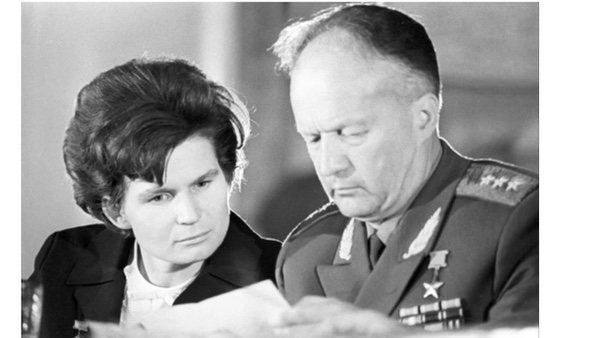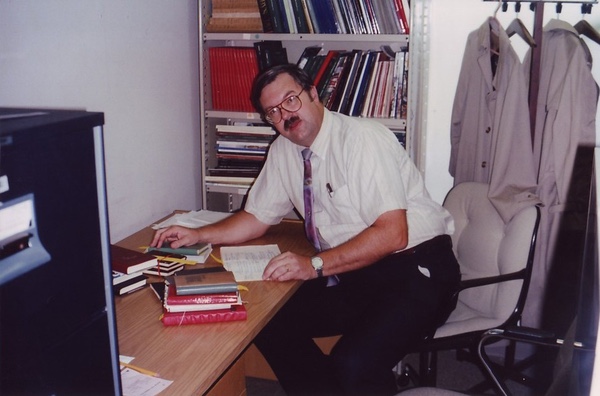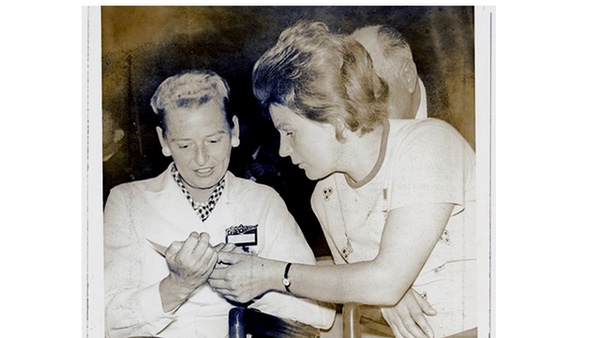Assessing and celebrating the global impact of the “First Lady Astronaut Trainees”by James Oberg
|
| It now seems that Tereshkova’s flight was organized by Moscow specifically in response to their awareness that the Americans were considering flying women on their spacecraft in the near future. |
Funk was the youngest member of a group of women pilots who in 1960 were privately evaluated for physical and psychological qualifications for spaceflight in a series of tests performed at the Lovelace Clinic in Albuquerque, New Mexico. Preliminary results were announced at the second International Symposium on Submarine and Space Medicine in Stockholm, Sweden, on August 18, 1960.
But while most of the American women passed those ground tests, none had been through the lethal-risk experiences associated with high-performance jet operations and testing, so they were not considered for NASA astronaut selection. The controversy over that criterion was a political storm at the time and inspired many spaceflight-minded women to push for wider access.
This push was further fueled in 1963 when the USSR sent a woman cosmonaut into orbit. Valentina Tereshkova, 27, was not a pilot at all, and in three days racked up more time in space than the first six Mercury astronauts had in the previous two years.
In recent years, an ironic historical twist has emerged, one that gives Funk’s upcoming flight even more poignancy. It now seems that Tereshkova’s flight was organized by Moscow specifically in response to their awareness that the Americans were considering flying women on their spacecraft in the near future. Russian space medicine experts would have learned about the Lovelace tests from the 1960 conference, if not before.
At the time of Tereshkova’s flight, it was hailed both in Moscow and widely overseas as proof of Soviet society’s superiority in granting women equal professional opportunities. Subsequent historical research instead has exposed it as what cynics had suggested at the time: a one-off propaganda stunt, albeit with beneficial long-range repercussions.
So, the legacy of the Lovelace test program involving Funk and her colleagues was far more profoundly inspirational than they ever realized. It launched both nations onto the path of opening space for women participants.
Dr. Asif Siddiqi, a leading historian of the Soviet space program at Fordham University in New York, has studied recently released personal diaries of General Nikolay Kamanin, who was the first commander of the Soviet cosmonaut corps.
 Valentina Tereshkova and Nikolay Kamanin, who argued that the Soviets needed fly a woman to space before the Americans. |
In a diary entry on October 24, 1961, he wrote: “After the flight of Gagarin [April 12, 1961] , I persuaded Vershinin, Korolev and Keldysh to agree to the recruitment of a small group of women, but so far this matter is progressing with great difficulty.” He listed several justifications, including a stark warning: “We cannot allow an American to become the first woman in space - it will insult the patriotic feelings of Soviet women.”
| “We cannot allow an American to become the first woman in space - it will insult the patriotic feelings of Soviet women,” Kamanin wrote. |
Siddiqi added: “The idea was then approved at the highest levels only in December 1961 with a major Party and government decree.” And the following May, on a visit to Washington DC with the second Soviet cosmonaut Gherman Titov, Kamanin wrote that during a visit to the home of John Glenn, he learned that several American women were in preparation for a space flight that could occur by the end of the year, which further inspired his campaign to upstage it
According to Bart Hendrickx, a spaceflight historian in Belgium, in February 1962 Kamanin wrote that he was reviewing applications from candidates. “We need young, physically strong girls who already have experience in flight and parachute training, whom we could prepare for the flight in 5-6 months. The main goal of such accelerated preparation, I see, is to prevent the Americans from getting ahead of us in order to continue to delight the world with our successes in space.”
Years later, upon meeting pioneering American woman-pilot Jerrie Cobb, Tereshkova told her that she was her role model and asked, “we always figured you would be first. What happened?”
 Beginning soon after the collapse of the USSR, a series of extraordinary spaceflight private journals began appearing. At Sotheby’s in New York in 1993, Oberg is examining the private diaries of Valeriy Mishin, the successor to Sergey Korolev. Later, the diaries of Nikolay Kamanin, commander of the cosmonaut team in the 1960s, became available for other historians to study. |
What happened with NASA had been the application of the Eisenhower stipulation formulated in 1958: experienced military test pilots would be the candidate pool for NASA’s first astronauts. Specific skills, not just psychological and physiological parameters, would be the crucial factor.
What had been missing in those early American women candidates was a reliable determination of their mental reaction to lethal threat. Most people freeze up, or run away, or lash out mindlessly. A few—those with what test pilots called “the right stuff”—can keep thinking and focus on selecting among alternative actions to counter or evade the threat. That mental steel is not some characteristic that can be measured in a laboratory by some white-coated clipboard-toting medical technician presenting a subject with a zero-threat imaginary game.
The only reliable indicator that somebody, man or woman, possesses it is to see it demonstrated under real-life conditions. But fatality rate of the World War II women fliers was 3%, while fatality rate for male astronaut trainees in the 1960s was 30%, so opportunities to demonstrate the skill were very rare for the women. For reasons now generally recognized as cultural, in that era, such flying—and dying—was reserved for male pilots.
Assuming simply that all these women must have had that required mental steel, with no track record, would have introduced a major new unknown hazard to an endeavor already considered to be near the very limits of the possible. There never was any implication that this was a gender-specific quality, but identifying it required exposing a group to threats so genuine that it killed some of them. There wasn’t any gentler way then, and there probably still isn’t. That first women's test group—the Lovelace Clinic 13—were unqualified for early spaceflight because, bluntly, enough of them hadn't already been killed in front of the others.
The men weren’t monopolizing the goodies out of greedy machismo, they were acting out of a quaint and now obsolete notion that women shouldn’t be crippled or killed. That was the missing factor in the US debate: proponents of flying women without such life-and-death experiences just demanded they all be assumed to have that mental quality.
Mercury flight experience validated the “Eisenhower standard” and showed it had been entirely justified. Of the six flights, at least two required exactly that “right stuff,” and in two other cases there was long argument over whether astronauts had not met the need. So even with intense screening it had already been a high risk, on the very brink of the impossible. Any deliberate decision to enhance the risk might well have had disastrous consequences in those early years.
| These women earned much more. They don’t need to piggyback on the name of any male-related project: they were the godmothers of female space fliers all over the planet and beyond. |
To repeat: It wasn't just physiology or flight hours, it was the level of experience with high-performance flight hazards the candidates had faced, the consequent death rate of the cadres, and the winnowing out by shear survival of those whose brains turned out to be able to retain function under lethal terror. Without that winnowing, the presence of that skill was only a matter of guesswork, in that era.
In the bigger picture, regarding the Russians, what these newly recognized perspectives indicate is that the consequences of the 1960-era medical tests on Funk and her colleagues had even more profound influence then is still generally realized on the future courses of both Soviet and American human spaceflight. Other women followed from Great Britain, Canada, Germany, France, Italy, Iran, Japan, Korea, and China, with more to come. They transcended local rivalries, political passions, and even diplomatic confrontations. They had literally universal impact. Well done.
One final thought. Even just referring to them as the "Mercury 13", the gimmicky and intentionally misleading term invented 30 years later by a male journalist, is obsolete and ripe for retirement. That semantic exploitation of a single short-term government project, of genuine physical risk, that for no fault of their own they really were not allowed to become qualified to compete for, is too limited. These women earned much more. They don’t need to piggyback on the name of any male-related project: they were the godmothers of female space fliers all over the planet and beyond. And that is more than adequate grounds for celebration of their achievements, in their own right, under their own designation: the FLATs (First Lady Astronaut Trainees, while gently stretching the meaning of the word “trainee.”)
And now, one FLAT is finally rising into space. Well done, indeed!
Note: we are using a new commenting system, which may require you to create a new account.
